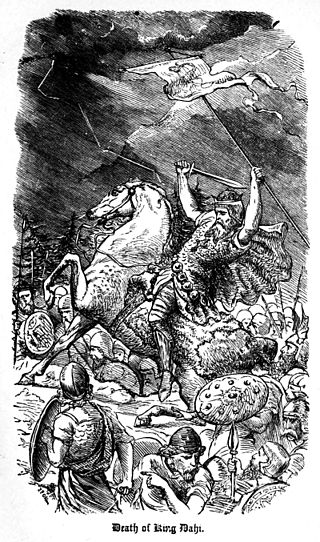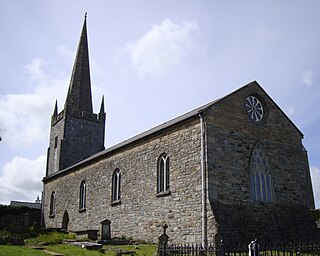
Uí Fhiachrach Aidhne was a kingdom located in what is now the south of County Galway.

Nath Í, also known as Dathí, son of Fiachrae, son of Eochaid Mugmedon, was a semi-historical Irish king of the 5th century, the father of the likely-historical king Ailill Molt and the ancestor of the Uí Fiachrach dynasties of early medieval Connacht. His mother was Béḃinn. According to legend, he was a High King of Ireland, and died after being struck by lightning while on an expedition to the Alps.
Ailill mac Nath Í, called Ailill Molt, is included in most lists of the High Kings of Ireland and is also called King of Connacht. His cognomen, molt, means "ram" but its origin is unknown.
Niall mac Áeda, called Niall Caille to distinguish him from his grandson Niall mac Áeda, was High King of Ireland.

The Bishop of Killala is an episcopal title which takes its name after the village of Killala in County Mayo, Ireland. In the Roman Catholic Church it remains a separate title, but in the Church of Ireland it has been united with other bishoprics.

The Uí Briúin were a royal dynasty of Connacht. Their eponymous apical ancestor was Brión, son of Eochaid Mugmedon and Mongfind, and an elder half brother of Niall of the Nine Hostages. They formed part of the Connachta, along with the Uí Fiachrach and Uí Ailello, putative descendants of Eochaid Mugmedon's sons Fiachra and Ailill. The Uí Ailello were later replaced as the third of the Three Connachta, through genealogical sleight of hand, by the Uí Maine.
Cellach mac Máele Coba was an Irish king and is said to have been High King of Ireland.
Conall mac Máele Coba, called Conall Cóel, was an Irish king and is said to have been High King of Ireland.
Eógan Bél mac Cellaig was a king of Connacht from the Uí Fiachrach branch of the Connachta. He was the grandson of the high king Ailill Molt. His reign began sometime after 500. His byname bél means "mouth" or "lip," supposedly because he received praise from all who encountered him as a child. Other sources claim he had a cleft lip.
Rogallach mac Uatach was a king of Connacht from the Uí Briúin branch of the Connachta. He was the son of Uatu mac Áedo, a previous king. He married Muireann, the great-great-great-granddaughter of Túathal Máelgarb, High King of Ireland. He acquired the throne of Connacht after defeating the previous king Colmán mac Cobthaig of the Ui Fiachrach Aidhne, who was slain at the Battle of Cennbag in 622. Professor Francis Byrne believes he is the first reasonable representative of this branch to be said to have held the throne of Connacht
Guaire Aidne mac Colmáin was a king of Connacht. A member of the Ui Fiachrach Aidhne and son of king Colmán mac Cobthaig. Guaire ruled at the height of Ui Fiachrach Aidne power in south Connacht.
Diarmait was a son of Áed Sláine. According to the Irish annals, he was High King of Ireland.
Blathmac was a son of Áed Sláine. According to the Irish annals, he was High King of Ireland.
Events from the 7th century in Ireland.

Saint Cuimín is an Irish saint associated with the parish of Kilcummin in the barony of Tirawley, County Mayo. Kilcummin, a headland to the west of Killala Bay, preserves the remains of a religious site, with a church of early date and a graveyard.

Ibar mac Lugna, whose name is also given as Iberius or Ivor, was an early Irish saint, patron of Beggerin Island, and bishop. The saint is sometimes said to have been one of the "Quattuor sanctissimi Episcopi" said to have preceded Saint Patrick in Ireland, although possibly they were just contemporaries. His feast day is 23 April.
The Uí Fiachrach were a royal dynasty who originated in, and whose descendants later ruled, the coicead or fifth of Connacht at different times from the mid-first millennium onwards. They claimed descent from Fiachrae, an older half-brother of Niall Noigiallach or Niall of the Nine Hostages. Fiachrae and his two full brothers, Brion and Ailill, were the collective ancestors of the Connachta dynasty that eventually became the new name of the province. Their mother was Mongfind.
Saint Fiachra was the Bishop of Armagh, Ireland from 548 to 558.

Cairbre Drom Cliabh was an Irish túath in the ancient confederation of Íochtar Connacht, now County Sligo in the west of Ireland. It is now represented by the barony of Carbury. Also known as Cairbre na Catha. It existed from at least the 6th century to the 16th century AD.
Saint Corbmac, also known as Cormac mac Eogain, was an Irish saint.





